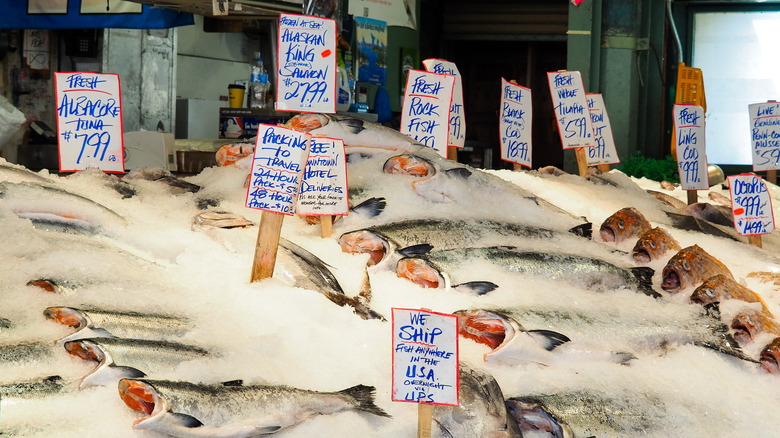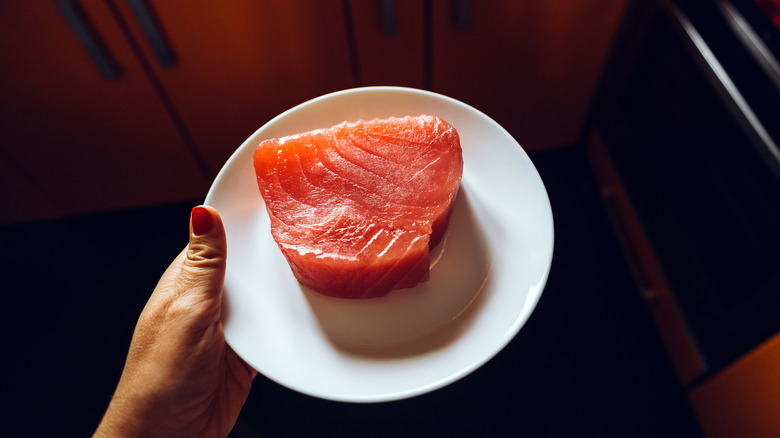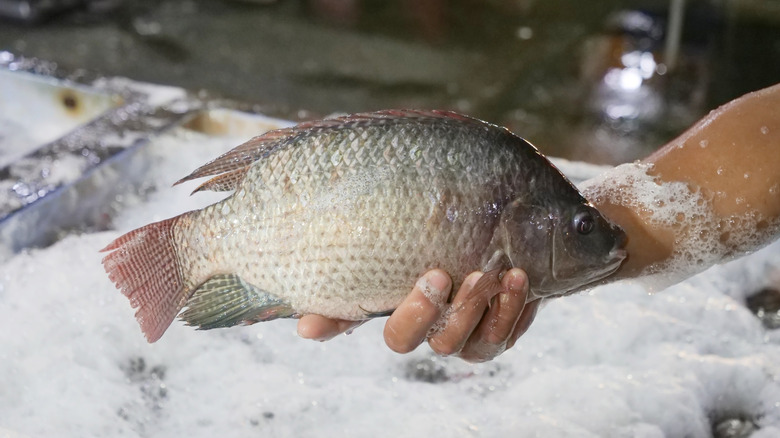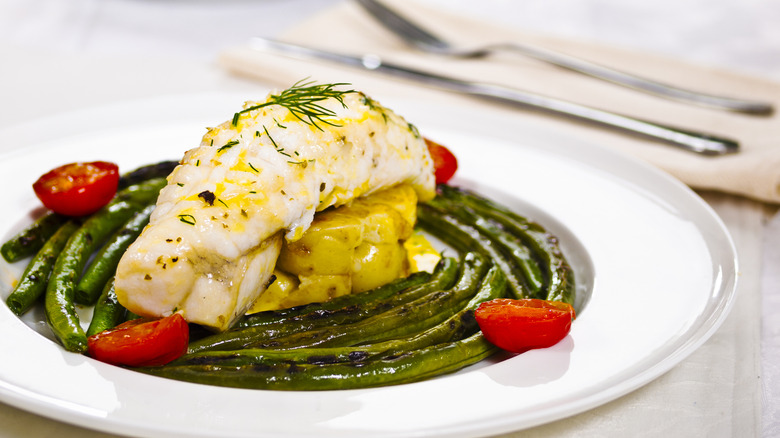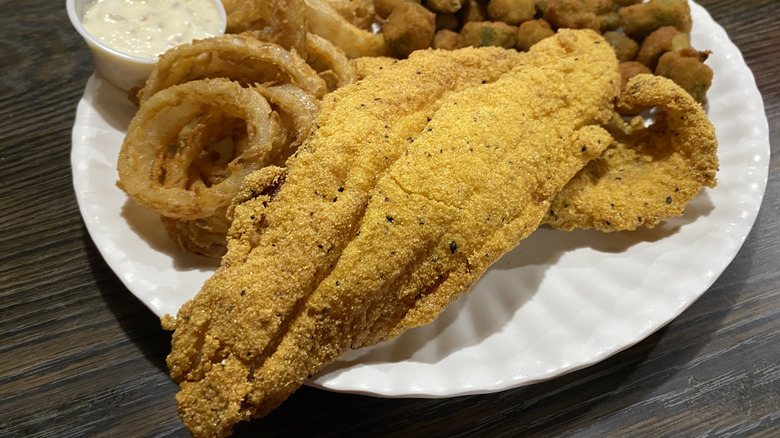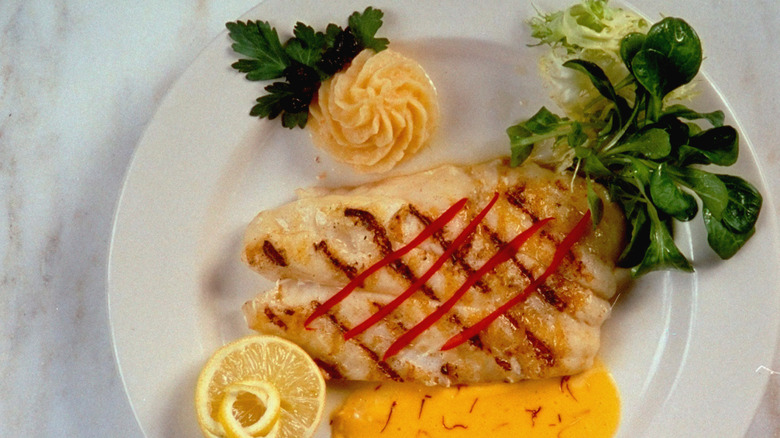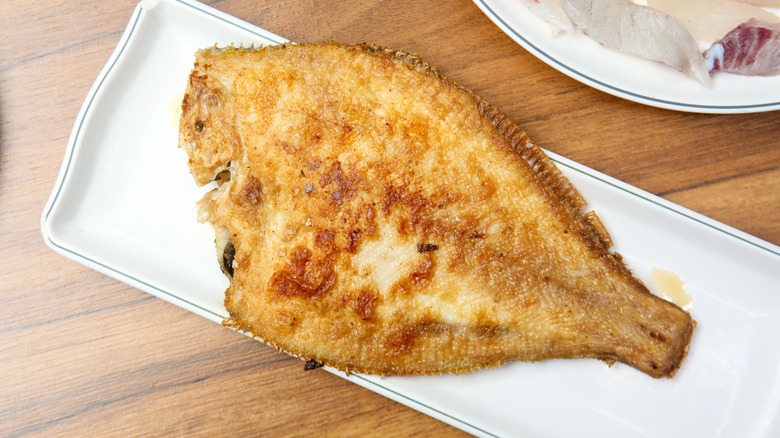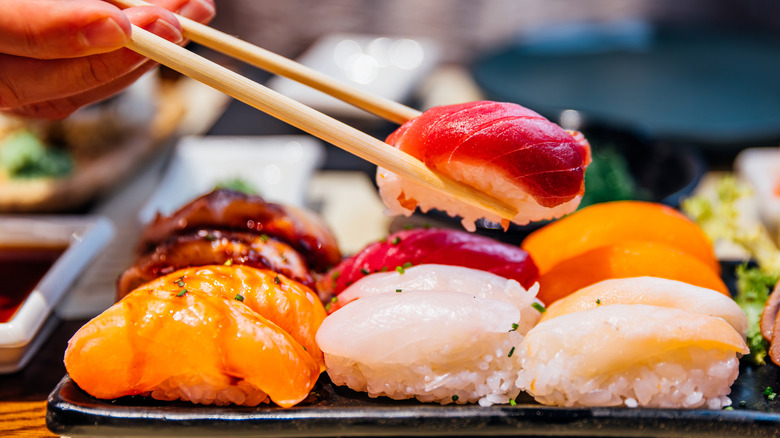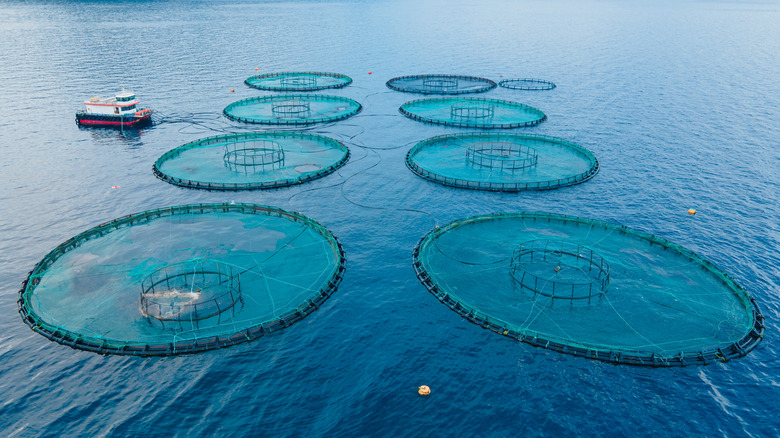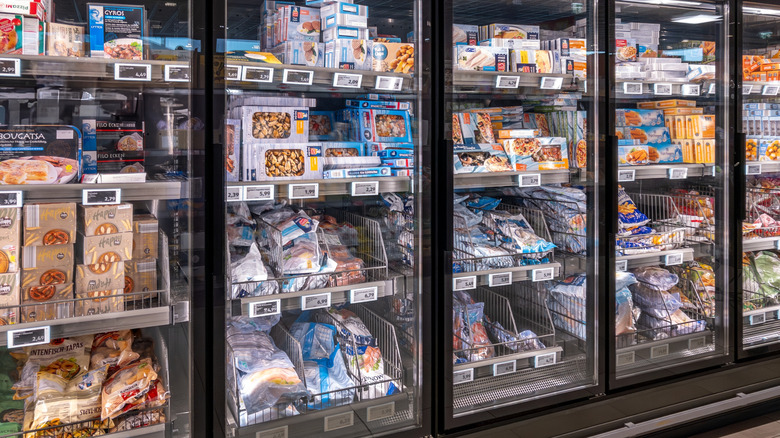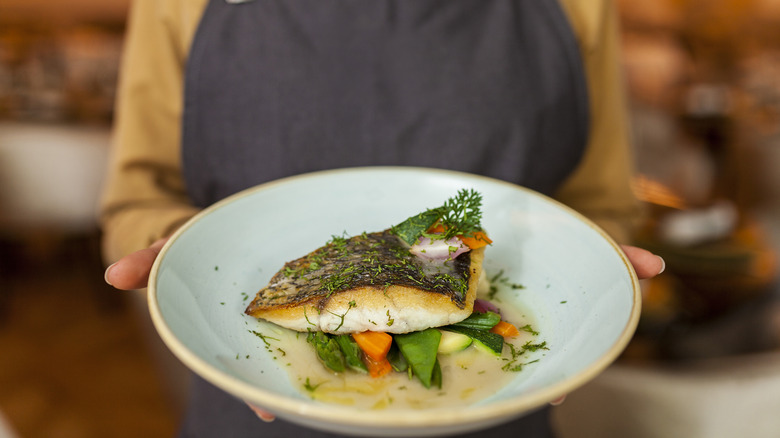10 Cheap Fish That Are Absolutely Not Worth Buying
You're perusing the seafood section of your local market, and you come across what seems like a great deal — but is it really? Compared to chicken or beef, seafood can seem like an expensive ingredient choice, so when you see a lower price than normal, you might be tempted to snap the item up quick. However, there are certain cheap fish and seafood items that you should avoid, even if the price tag is appealing. Some are just not worth buying for a variety of reasons — they're difficult to cook, you can get a much better product if you spend a little more, the fish's quality is negatively impacted by poor farming and fishing practices, and the list goes on.
To discover the cheap fish that are absolutely not worth buying, no matter the sweet deal you think you're getting, we spoke to multiple chefs in the know. Chef Jose Molina is the executive chef at The Wilson restaurant at INNSiDE New York NoMad Hotel, which offers all-day seafood and a "town-by-the-sea" atmosphere. Chef William Eick represents Matsu, an Oceanside, California, fine-dining Japanese restaurant with a menu featuring a wide variety of seafood. Chick Evans is the founder and owner at Maxie's Supper Club & Oyster Bar in Ithaca, New York, with its raw oyster bar and fresh seafood. Lastly, Chef Laurent Tourondel helms LT Steak & Seafood at The Betsy Hotel South Beach in Florida. Here's what they had to say.
1. Tuna
You likely see tuna on a wide variety of high-end restaurant menus, and it's not typically the most budget-friendly fish on the market (unless you're buying canned tuna, which we've ranked to help you find the best brands) — so why is tuna something that you'd want to avoid even if you find a good deal? According to our chefs, it just comes with too many complications to be worth buying as a home cook unless you're particularly adept at working with seafood.
According to chef Jose Molina from The Wilson restaurant, tuna can be "tricky" due to freezing and defrosting processes necessary for proper preparation, comparing it to lobster in terms of at-home difficulty. Additionally, he said, tuna dishes typically require multiple ingredients for the prep process, so at-home cooks could find simpler options if they're hoping to cook up a budget-friendly seafood feast. Specifically, he recommends mahi-mahi, cod, calamari, or shrimp. He also recommended salmon, saying all you need to add is salt, pepper, and Old Bay seasoning. Serve any of his recommended fish with lemon butter sauce and toasted sourdough, and you have a restaurant-worthy fish dish for a reasonable price.
Along the same lines, chef William Eick from Matsu says that if your recipe calls for baking or broiling, it's not worth dropping the money on fresh tuna. "[For] anything cooked beyond medium-rare," he said, "you might as well just buy canned tuna." And even then, there are plenty of mistakes to avoid when working with canned tuna.
2. Tilapia
Tilapia is widely popular, cheap, and easy to cook. For these reasons, it's one of the most common whitefishes, with per capita consumption in the U.S. at about a pound a year. However, don't let tilapia's affordable price fool you. This fish isn't as good a deal as it seems.
Chef William Eick says he would avoid tilapia 10 out of 10 times, adding, "It's typically raised in very poor conditions, not cared for during processing, and overall is just a low-quality fish that isn't worth the price, no matter how cheap."
Tilapia has been called a garbage fish due to poor farming practices. Just how bad are the conditions that your tilapia may be exposed to before it makes its way to your dinner plate? Most of the tilapia in the United States is farmed in Asia or Latin America. Reports have circulated about the fish at these farms feeding on animal waste, being exposed to illegal chemicals, and containing illegal antibiotics and antimicrobials. Because of these issues, many recommend avoiding tilapia from China altogether. Additionally, at poorly managed farms or farms apt to flood, tilapia may escape and enter the local waterways, where they become an invasive species, spreading disease and taking resources from the native fish. If you absolutely have to eat tilapia, look for tilapia farmed in Colombia, Indonesia, or Taiwan and certified by the Aquaculture Stewardship Council (ASC), Global Seafood Alliance Best Aquaculture Practices (BAP), or Naturland.
3. Monkfish
You may not be as familiar with monkfish as you are tilapia or tuna, but it is a relatively affordable fish that's found in restaurant kitchens more often than home kitchens. Monkfish is sometimes called "the poor man's lobster," due to the supposed similar taste and texture found in the fish's tail — the only part of the fish that's edible and sold. Monkfish has also been called "the veal of the sea," and you can find it cooked a wide variety of ways, including roasted, grilled, breaded and sautéed, braised, or seared and placed in a sauce.
However, despite this versatility and affordability, monkfish may still not be worth the cost, according to Chef Laurent Tourondel of LT Steak & Seafood. He says that he's personally not a fan of this fish and, while it's cheap, the texture can be "weird" (so maybe not so like lobster, after all!). Tourondel sums up: "It's just not worth it. If I'm spending money on seafood, I want something that feels like a good value, and monkfish doesn't do it for me."
One type of seafood that Tourondel does say is worth the value even if you might pay a little more? Fresh stone crab, which he says offers a "perfect firm, sweet bite" — so long as you truly go for the fresher, thus better, stone crab.
4. Catfish
Catfish is an affordable favorite, particularly in the southern United States. In fact, it's so affordable that the food service industry has posed that catfish may be a good, cost-effective solution to restaurants facing recent rising food costs, citing the fish's affordability, versatility, and, depending on where you buy it, sustainability. Catfish is low in mercury, and it also offers lots of lean protein, omega-3 and omega-6 fatty acids, and vitamin B12.
That said, you may want to think twice about buying this cheap fish. In a past Food Republic interview, chef and restaurateur Douglas MacMillan of Ada's Fish House in Pismo Beach, California, named imported catfish as one of the fish he would avoid as a seafood chef.
While catfish may be one of the country's top 10 most popular fishes, the majority of catfish we eat in the United States is imported. Imported catfish may come packed with unsafe levels of antibiotics and banned chemicals, particularly if those catfish were raised in either China or Vietnam. If you are going to eat catfish, make sure that it's farmed in the United States. Specifically look for catfish farmed in shallow ponds. This popular U.S. farming method actually benefits the surrounding environment, as the ponds act as artificial wetlands. In contrast, the catfish ponds used in China and Vietnam produce a substantial amount of waste.
5. Orange roughy
Like monkfish, orange roughy may not be a fish that you're all that familiar with, as it's not as commonplace on menus or at your standard grocery store. This fish is sometimes also called deep sea perch. About 80% of the world's orange roughy is sourced from New Zealand, where the country boasts the first Marine Stewardship Council-certified sustainable orange roughy fishery in the world. In the Food Republic interview, chef and restaurateur Douglas MacMillan, though, placed orange roughy among some of his top fish that he wouldn't eat as a seafood-focused chef.
The reasons to not eat orange roughy are myriad, despite its general affordability, attractive taste and texture, and versatility. For one, orange roughy can grow to be quite old, over a century in age. The older the fish, the more mercury it contains (see which fish have the highest and lowest mercury levels). In fact, the Environmental Defense Fund has even issued a warning against eating orange roughy due to this mercury content, saying that you should only eat the fish, at most, twice per month if you're a woman or once per month if you're a man. The organization also noted that it had considerable ecological concerns regarding the fish's farming and catching practices. These concerns are particularly connected to bottom trawling fishing, a practice that damages the ocean floor and results in bycatch (or fish that the operation didn't intend to catch, but that were swept up with the orange roughy).
6. Fluke
You may not know this fish as a fluke, but you may recognize its other name: flounder. A very in-demand fish, it's often caught in the Atlantic and sold fresh. It's considered a sustainable fish due to careful fishing rates and bycatch regulations. The one sustainability concern when it comes to fluke is bottom trawl fishing practices, which can harm the ocean floor. However, the flounders' natural habitat is a little more resilient when faced with bottom trawls, lessening the impact.
Still, chef Laurent Tourondel of LT Steak & Seafood says that he personally never uses fluke as a chef. "It's cheap and you can really taste the difference," he told us. "It reminds me of a low-quality version of Dover sole. It just doesn't have that same clean, delicate flavor. If I'm going for white fish, I'd rather spend a little more for something that really holds up."
Flounder and sole are actually not all that different in terms of sustainability and nutritional benefits, so there's no worry there if you want to upgrade to Tourondel's preferred sole. Both are flat fishes. Both are easy to cook and work well in a variety of cuisines and dishes. Both are also filled with lean protein, omega-3 fatty acids, vitamin D, selenium, and vitamin B-12.
7. Fish that's not sushi-grade
If you're making sushi at home, there's one thing you absolutely have to get right when you're shopping for your fish, not just for taste and texture, but for safety reasons as well. Chef Laurent Tourondel advises that you absolutely must not cut corners, and you must always pay for sushi-grade fish. While you could be considering cheaper fish that's not sushi-grade, it's not worth it as fish that's not sushi-grade, when used as sushi, comes with a high food poisoning risk.
So how can you make sure you're buying sushi-grade fish? It starts with understanding what exactly sushi-grade fish is. Since there is no formal, government-ordained grading practice for raw fish, the sushi grade distinction is left up to the individual seller. This is why buying from a reputable seller is ultra-important. That said, the U.S. Food and Drug Administration does provide guidelines around the safest way to handle fish that will be eaten raw, so typically if a fish is handled this way, it may be labeled sushi-grade. The fish will be frozen according to precise specifications, for one. This freezing process will kill any parasites that may be in the fish. Consuming a parasite in raw fish can lead to significant issues, ranging from severe gastrointestinal illness to conditions that require endoscopies or surgeries. Doesn't sound fun, does it? Luckily, these parasites are less of a risk if you purchase sushi-grade fish from a reputable seller.
8. Farmed fish
According to Chick Evans of Maxie's Supper Club & Oyster Bar, farmed fish is generally priced lower, and will be more readily available, than wild varieties. It's similar to the way that factory-farmed chicken is going to be cheaper than pasture-raised, organic chicken from a small farmer.
However, farmed fish's cheap price comes with a greater cost in terms of potential risks to your health. When it comes to frequently farmed fish like tilapia and catfish, one of the major risks is contamination. Farmed fish may contain certain industrial chemicals that are intended to change the fish's appearance — for example, making salmon look pinker — and/or antibiotics that the fish require to stay healthy in a poor farming environment. Those substances can be passed on to the consumer. In general, farmed fish also contains lesser quantities of beneficial nutrients, like omega-3 fatty acids, when compared to wild-caught fish. Additionally, farmed fish introduce environmental hazards into their surroundings, including diseases, parasites, and concentrated fish waste; meanwhile, if farmed fish escape, they may become invasive species.
That's not to say that farming fish is negative across the board. Sustainable farm fishing is possible. Methods of making fish farming more sustainable include moving farming operations into the open ocean, recycling water for land-based fish-farming operations, and experimenting with new kinds of fish feed. So, before you simply buy farmed fish because it's cheaper, think about the risks and make an effort to buy either sustainably farmed fish or wild-caught fish.
9. Frozen fish
Yes, frozen fish is cheap and convenient. That said, Chef Laurent Tourondel explains that it's just not worth it. "Freezing kills the freshness and takes away so much of the flavor," he said. "If you want great-tasting seafood, fresh is always the way to go."
Chick Evans concurs — and he offered a few tips to help you make the most of your fresh, high-quality fish. He said to always make your fish purchase either the day you plan on cooking the fish, or, at earliest, the day before you plan on cooking the fish. Before the fish monger wraps the fish, give it a smell and watch out for any unpleasant odors. Ask the fish monger for some ice, too, so you can keep the fish on ice (indirectly!) from the moment it leaves the store to the time it gets to your fridge. Keep a cooler in your car for this purpose, and only take your fish off the ice once you're ready to prepare it.
Just like it's vital that you buy your sushi-grade fish from a reputable seller that you trust, it's also vital that you buy your fresh fish from a reputable seller that you trust. This is because, sometimes, the fish the store is advertising as fresh isn't really fresh. Instead, it could be the case that the seller purchased frozen fish, thawed it, and then let it set in the display until it sold.
10. The fish special
But what about fish that you're not going to cook yourself? Are there fish you should not buy at a restaurant? Absolutely — and that fish to avoid is no specific fish, but the fish special in general. Often available in the earlier part of the week, when business is slow and as an effort to draw in customers, fish specials may seem like a good deal, but you're likely not getting the best, freshest fish possible. In fact, it's more likely that you're getting fish that's been sitting around for a while.
In a Mashed interview, Chef Felix Tai, executive chef at the Polynesian Cultural Center in Hawaii, gave an example: "Here in Hawaii, all the fresh, local fish comes from the auction, and it's closed on Sunday, so unless the delivery was made on Monday morning, I wouldn't want to eat the special that has fish in it. It could have been old fish that is no longer superior."
While the old adage that restaurants only receive fish deliveries twice weekly, Tuesday and Thursday, meaning if you want fresh fish, you should plan to dine at the restaurant Tuesday through Friday, is largely considered no longer valid, it's still the case that deliveries may not occur on Sunday, as Chef Tai pointed out. In short, to be guaranteed the freshest fish possible, no matter where you dine, consider skipping the Monday fish special.
Static Media owns and operates Food Republic, Mashed, and The Takeout.
